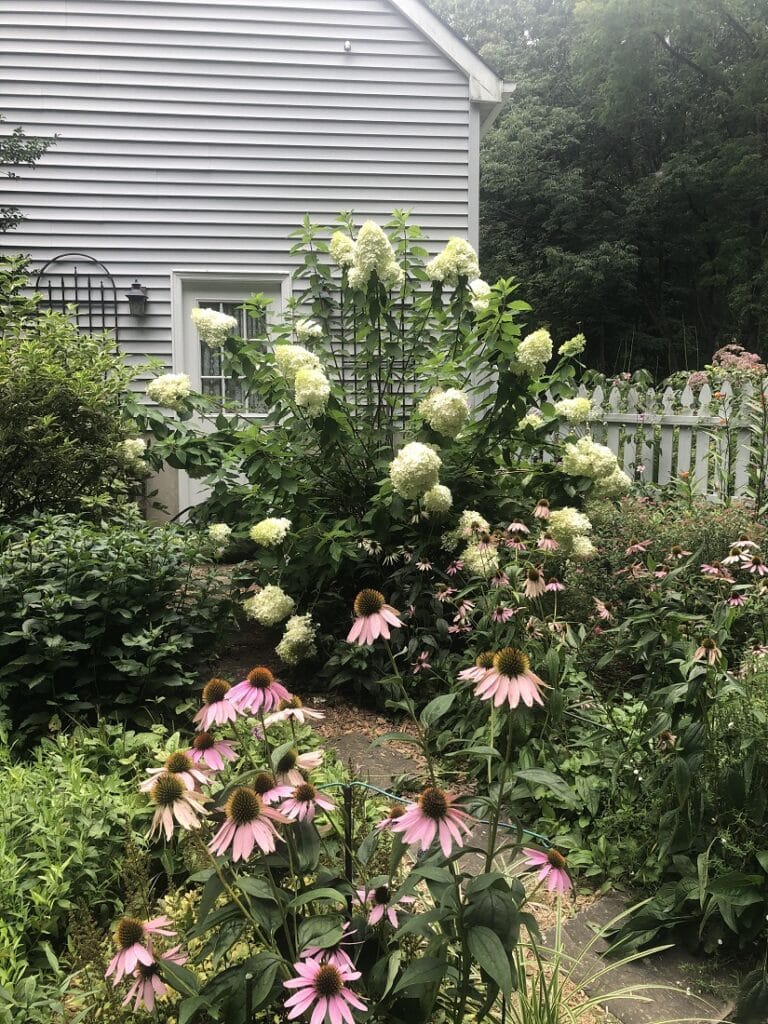Hello, fellow lovers of all things green. In the spirit of our recent chats about hydrangeas and a heartfelt anniversary, I’d like to revisit a story about flopping Limelight Hydrangeas and introduce you to a newer variety that solves the bowing blossoms of Limelights.
Lorraine from Sparta, NJ, wrote, “Hi, Mary! I have a Limelight Hydrangea garden dilemma. I prune it every spring to about three feet. It grows to about six or seven feet tall and wide by August with ginormous blooms. But with the heavy rains, the stems can’t support the heavy blooms. They don’t break; instead, they bend over gracefully, but the blooms are very low or near the ground.”
Lorraine and I became friends when she organized the speakers for the Springfest Garden Show. It was sad when the show retired, but how blessed connections along the garden of life journey continue to grow.
 Panicle Hydrangeas are easy keepers.
Panicle Hydrangeas are easy keepers.
As dear old Mom would say, all panicle hydrangeas (Hydrangea paniculata) are easy keepers, growing in most soils that drain well. If yours is clay soil, then amend it before planting. They tolerate drought once established. And, because they bloom on new wood, they can endure cold winters and still bloom.
“Can Limelight Hydrangea be pruned a second time in late spring or early summer to reduce the size of the blooms? I recently severely cut back a large viburnum that was crowding it but also supporting the plant.”
Quick-Fire vs. Limelight
Lorraine sent the photos of her voluptuous Limelight’s bowing down. “You can see the Quick-Fire on the left is nice and upright. Most of the Limelight blooms are close to the ground.”
Quick-Fire, like Limelight, grows about eight feet tall and can be pruned into a tree form. It’s one of the first panicle hydrangeas to bloom in early July and can thrive in part sun. It starts white before turning pink, then darkens to reddish pink towards fall.
Limelight’s football-shaped light green flowers bloom in late summer and age to pinkish-red and maroon. They require at least eight hours of full sun to stand tall. I wonder if Lorraine’s neighboring viburnum may have shadowed her Limelight, contributing to its floppiness, as not enough sun often causes weak branching and fewer blooms.
Fixing Flopping Limelight Hydrangea
While you can’t reduce the size of blooms, the most popular protocol for pruning Limelight Hydrangeas is to cut them back by a third of their height (rather than half) in early spring. This safeguards the plant from flopping, as the new season’s growth will come from the heavier, thicker buds lower on the plant.
Recently, ‘Limelight Prime’ was introduced, which grows four to six feet high with about a four-to-five-foot spread and thrives in part or full sun in Zones 3 to 8. It also flowers earlier than Limelight, so if you’re in a colder zone, you don’t have to wait till late August to have flowers. The green flowers age to white with pink and reddish tones, and a drum roll, please, the stronger stems support the big blooms. Its popularity quickly took off, fixing the bowing blossoms of Limelights in the garden.
Losses and new beginnings are part of life.
A side note: Lorraine’s flopping Limelight dilemma came four years ago when I lost Miss Ellie Mae. The “coincidence” is that Jolee’s rescue paperwork indicates she was born about the same time. There’s something beautiful about that.
Lorraine checked in with me a few days after Ellie passed away, asking how I was doing.
“I’m doing fine. We’re missing our dear girl, of course, but I’ve gotten pretty good at the grieving process. I am giggling as I write, as I’m unsure about that. As we get older and have more experiences, we may go through loss a bit easier, but not always. Grief has a life of its own.
While endings are part of life, love remains forever rooted in our hearts. Then come new beginnings, like our dear Jolee and new plant introductions, to bring joy to our Garden of Life.
Garden Dilemmas? AskMaryStone@gmail.com (and your favorite Podcast App.)
There’s more to the story in the Garden Dilemmas Podcast (about ten soothing minutes):

Lorraine’s Less Floppy Limelight 2023
Lorraine sent an updated photo after reading this post: Hi Mary! I agree that the newer and smaller cultivars are not as floppy and have more but smaller flowers. I think I’ve been able to semi-remedy my issue by trimming all branches that face outward and keeping upward branches. But after tonight’s monsoon, they may all be on the ground!
Previous Related Posts you’ll enjoy:
Oakleaf Hydrangeas for All Seasons
 About my Unexpected Furry Messenger and a story about Jolee’s arrival Merry Season of Love over Fear
About my Unexpected Furry Messenger and a story about Jolee’s arrival Merry Season of Love over Fear






I happened upon your blog when searching for a solution for a flopping ‘Phantom’ Panicle Hydrangea. Phantom’s marketing description says it has huge blooms on strong stems and it doesn’t flop. Well, they were half right. It has enormous blooms but it is a total flopper. I did follow the pruning advice of trimming it back by 1/3. It grew nicely and is covered with the huge blooms. Everything was fine until it rained. All the branches except one are bent over and the flowers are touching the ground. I had hoped when the flowers dried, they would bounce back but that didn’t happen. I even tried encouraging the branches to go back upright but that didn’t help,
I would really like to know if there is a pruning solution for flopping panicle hydranges.
Hello Laurel, I never planted ‘Phantom Panicle’ Hydrangea. Thank you for introducing me to it. You did the proper pruning, but heavy rain damages the blooms that sadly may not bounce back. It reminds me of my peonies’ annual dilemma: Just when they are in full flower, Mother Nature usually decides to offer a torrential storm.
One wonders why we garden. Because we adore the beauty and therapeutic aspects despite the challenges. Teaching us that Mother Nature is in control :^) Thanks for reading my column, Mary
Thank you for the wonderful article! I am hoping you can help me with a beautiful old limelight tree that I inherited when I bought my new house. The limelight tree was pruned back by the previous owner and so this summer it had big beautiful blooms that all bent gracefully downwards after the first heavy rain. It looks like a weeping tree but I would prefer if they stayed straight! I would like to prune it just a but next spring so that the blooms are not as large and we wont have so much flopping but am worried that the current branches will “freeze” in this curved shape if I wait until then. Fo you have any advice for this??
Hi Susan, Thanks for your kind words and for reading my story. The most published protocol for pruning is cutting panicle hydrangeas back by a third of their height (rather than half) in early spring. Thereby safeguarding it from flopping as the new season’s growth will come from the heavier, thicker buds lower on the plant. But you can’t change the size of the blooms. I hope this helps, Mary
The information you provided is great. I have 3 10 yr old limelights and faithfully every spring I trim them about 1/3. They have always responded by growing to 7 ft with the most glorious and humongous blooms. Fast forward to last March. Husband is a control freak and would be totally happy in a sculptured yard where everything is clipped to perfection. I’m the exact opposite. He fussed about the limelights and offered to trim. How far can I cut, he asks. I tell him about 1/3. Ok…he says…1/3 up from the ground. That’s what he did . When they bloomed, the skinny branches could not support the blooms. I had nice thick branches but no more.
Oh and 2 years ago he fussed about my 30 yr old Catawba rhododendrons. I have 3. So I said sure, we can do a rejuvenation. They ended up being little stumps. He finally admitted they looked bad. Yep…it will take a while for them. Meanwhile, I spray and feed.
However, he LOVES lirope I hate that with a passion. It has taken over what was a flower bed. He also LOVES Nandina. I’d like to find a brush killer I can paint on them and it would travel through all those roots and KILL those d%^*n things off!
He needs a plant that totally thrives on constant trimming.
Hi Renee, I am chuckling reading the saga of your “control freak” pruning hubby; though I’d be crying if it were me. And have! It took years to “train” Curt to leave everything that doesn’t look like a blade of grass alone. When he entered my life, a swath of ferns was weed-wacked to the ground. And hydrangea shrubs chain sawed to 3 inches, thinking they were the panicum grasses I asked him to cut. Darn! It always amazes me that some folks like to turn plants into something they aren’t meant to be. Never mind liking invasive plants. Maybe you can divide your yard and give him the part you can’t see. Or take away his power tools. Ha! Good luck! Thanks for sharing your story, Mary Stone